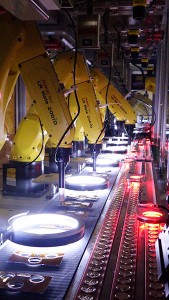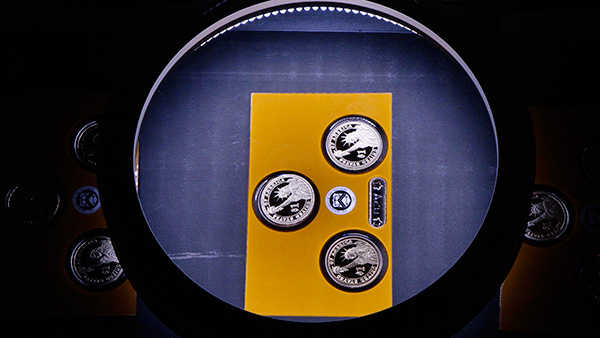By Adam M. Stump
March 23, 2016

Housed on the first floor of the United States Mint at San Francisco, a line of yellow robots move with precision over a conveyer belt. Behind the clear acrylic windows, each robot has a distinct mission assembling packaging and coins for various proof sets.
The robots are part of the facility’s Farason line, which was installed in 2010. The robotics loop, one of the cutting edge technologies used by the Mint, improving the quality and the rate of production for the sets San Francisco makes. The old line could produce at a rate of approximately 600 sets per hour. The new robotics loop triples that output at a rate of approximately 1,800 per hour.
The Farason line has been busy in recent months making the last year of the Presidential $1 coin series. The Presidential $1 Coin Program, which started in 2007 and honored all deceased United States presidents, will come to an end in 2016 when the United States Mint at San Francisco mints the last coins.
Packaging the 2016 coins once they’ve been minted, along with other proof sets made at the facility, falls to a series of robots tucked away in a corner of the San Francisco facility.
“The robotic loop makes us a technology leader,” said Dave Jacobs, the plant manager. “The line helps package the coins for the largest producer of proof coins in the world, the United States Mint at San Francisco.”
Robots of the Farason Line
Justin Hatch, a packaging machine operator leader in San Francisco, explained each of the robots and their purpose.
Robot 1 inspects the blister, or the pre-formed plastic insert. The robot picks up the blister and holds it against a tracking camera, which takes a picture and assigns a score to the item. If the score meets quality standards, the blister moves on. If there’s a quality problem with the blister such as a scratch or crack, the item gets sent down a slide into a reject bin.
Robot 2 takes off bottom trays and places them onto the belt. When this robot places the trays, it attempts to place them parallel to the belt.
Robots 3 through 8 are called “pick and place robots.” Their job is to pick up coins and place them into the trays. If the item is a three coin set, only robots 3, 4 and 5 are working. The other three robots are used for sets that involve sets with four, five or six coins.
Before each pick and place robot does their job, there’s a tracking camera that is inspecting the packaging and taking a measurement of the orientation of the packaging. Since the packaging could slightly move, the inspection cameras tell the robots to change the orientation of the coin.
For example, if the packaging is askew at a five degree clockwise shift, the tracking camera will take a photo and tell the robot that when it’s time to place the coin, the robot should shift the coin at a five degree clockwise twist so when the coin is placed, the coin is correctly oriented to the packaging. Since there’s a tracking camera before each of the pick and place robots, each robot may have to shift to a different angle if there’s any change to the packaging.
Robot 9 has a similar job to Robot 2, placing the top trays onto the belt, and then comes Robot 10, which places the top lens onto the belt.
While the first ten robots are moving with a steady flow, Robot 11 is the fastest and busiest robot in the line. This robot has to grab the insert, check it and place it into the lens set using a flipping method. The robot inspects the lens and insert, makes contact with the set to make sure the coin is at the proper height, places it into the lens set and assigns a score to see whether the set is good or should be rejected.
Robot 12 places the top lens, also assisting squaring and pressing the set to make it secure.
The last stop is Robot 13, which picks up three completed sets in succession and places them onto a trolley, which can hold 600 sets. When Robot 13 is picking up the sets, each one can be skewed at an angle up to 30 degrees and the robot will adjust accordingly to make sure the sets are correctly placed into the trolley.
Beyond the Farason Line
After the Farason line has assembled the lens sets, they move to an adjoining room to marry up with the Certificate of Authenticity, exterior carton and grouping into a box to get shipped to the distribution line. The cartoning line, as it’s called, has been at San Francisco for about 10 years.
While the line has a success percentage in the high 90s and moves at a rate approximately three times faster than the previous line, there’s still a need for human intervention, which is where the employees come into play. San Francisco workers are needed to perform maintenance, reset the machine if there’s a stoppage, collect the rejected blisters, coins and lenses, and replace any defective coins that may have been damaged by the robot.
Overall, the Farason line greatly improves the speed and quality of sets, ensuring customers receive the best product the Mint can make.

See more Inside the Mint articles


